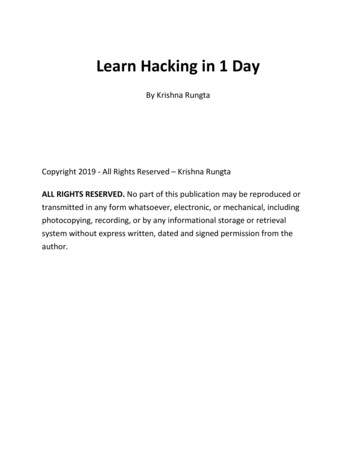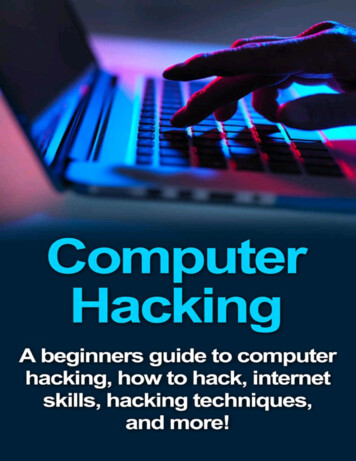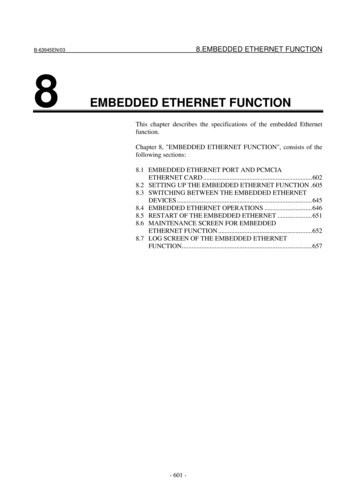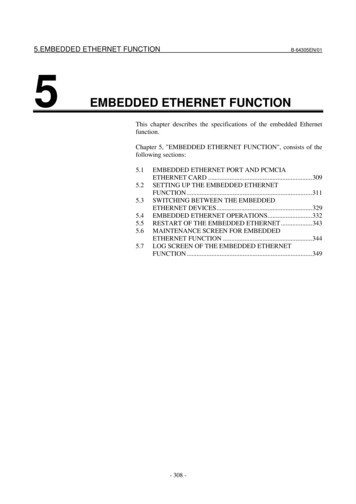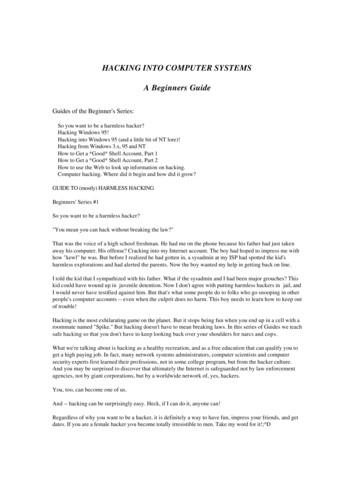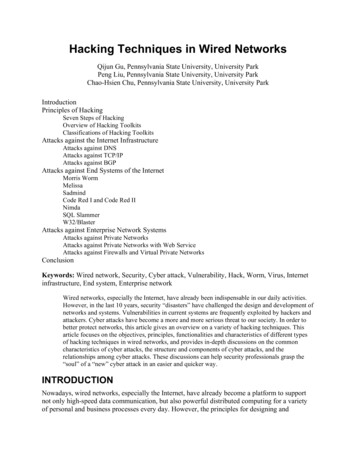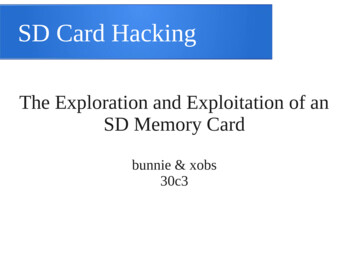
Transcription
SD Card HackingThe Exploration and Exploitation of anSD Memory Cardbunnie & xobs30c3
Origin: Searching forFakes
Card Teardowns
Solution: managed Flash Small embedded controller in every“managed Flash” device–8051 or ARM7 CPU–4-8mm 2 silicon 0.15- 0.30 costadd-on–Compare to Flash die area 100mm 2, 2.90 cost–Compare to test cost, wafer-scale tester 1mm 0.45 for a 30 second test(assuming 24 month lifetime and usage24x7x365)
Faking Reliability Flash memory is “unreliable”– Youare not storing data, you are storing probabilisticapproximation of your data– Workaround:computational error correction (ECC)[intechopen.com]
Also, Bad Blocks TLC/MLC Flash price is 0.1nano /bit– Onlyachievable because every piece of silicon fabricated is sold,regardless of fabrication errors – nothing is thrown away– Work around: bad block remappingIn some cases, over 80% of blocks are bad (e.g. 16GiB chip sold as 2GiB)– Also,blocks go bad with P/E cycles[xeltek][theregister.co.uk]
Why do it at this layer?Rainbow tablesApplicationOSJFFS, YAFFSBus controllerDevice controllerSSD, SD, USB mass storageRaw Flash Considering:– Flash geometry changes every 12-18 mosNew ECC rulesNew page size, block mappingIntensely cost-sensitive marketLowest cost, highest performing Flash chips are proprietary
The Concern This is the set up for a MITM attackWhat runs on the microcontroller? Can it behacked? Can I trust my Flash memory?My computerProgrammablemicrocontrollerRaw Flash
Fakes Turn In; NewQuest: Hack an SD Card Find and hack an SD card– Controlthe micro to make an LED flash, at a bareminimum– Challenge: no public docs available on controllersOur story– HardwareSD cards– Softwaretools developed to inspect, learn, and hacktools and static code analysis to discoverback doors and controller structure
Step 1: Acquire targets
SD Cards Ahoy
Card Survey
What's inside
Easy mode decap
Taps: gen 1 monolithic
Taps Gen2
Taps: gen 2, monolithicand discrete
Tap in-system
Tapping system diagram Capabilities:–FlashDDR3 memory (16-bit, 800MT/s, 256 MiB)DDR3ROM emulationDDR3 as Flash Dual-port implementation,mod and read on the fly –Interface loggingTrace capture of SD andFlash interface transactionsMulti-port 800MT/s DDR3 controllerLinux hostmmap()register interfaceto Novena hostFIFO to DDR3Data sampler(trigger on RE/WE)NovenaQuad-core ARM1GHz linux systemFLASHmemory emulator(aka “Romulator”)FPGAFLASHmemory chipFLASHmicrocontrollerSD cardFLASH memory chip isremoved or installed dependingon objective (i.e.,observation/logging or fuzzing)
ROM reader
Identifying a target Discrete implementation – more hacking options than monolithic SLC memory (unscrambled, trivially readable)– Easyto check for strings:“China Buildwin SD Controller,Anti Japig,Author:Y/G/S/P/X Date:2008 7”– Cross-check AX211against google Appotech controller, likely 8051
Factory Firmware Initial code had to get theresomehow– Tryto get ahold of the factory'sflashing tool
Obtaining software
Obtaining software
Programming tool
Strange filenames
About the 8051
About the 8051dd if /dev/urandom of firmware.bin bs 2048 count 1
About the 8051http://www.win.tue.nl/ aeb/comp/8051/set8051.html
About the 8051http://www.win.tue.nl/ aeb/comp/8051/set8051.html
About the AX211
About the AX211
About the AX211
Programming processOpen programmerStart burnCheck flash sizeSet up programmingProgram firmware2005FM.BINReadyBootLoad TestBoot.BINReadyResultsRun flash scan, sendResult back tohostOkayLoad code to RAM,Return OkayDoneWrite firmware toFlashLoad FLASH SCAN.BINLoad FLASH PRO.BINPassthruSDcommandsLoad correct BIN fileWait for next cardWindowsprogrammerx86Load SD interpreterAX2005programming jig8051AX211 SD card8051
SD Protocol: Hardware Signals:– CMD– DAT0– DAT3– CLK Signal integrity– Commands– Data use CRC7uses CRC16Also supports SPI mode
SD Protocol: Software 64 Possible Commands– CMD0:Reset / Go Idle– CMD10:Get CID– CMD41: ACMD– CMD60 “escape”– CMD63: Reserved for mfgr32 bits of “argument” data[SanDisk Product Manual V1.9]
SD Protocol: Response[SD Simplified Layer Spec]
Fuzzing knock sequence 64 possible commands– Only– 232 4 “manufacturer” commandspossible argumentsFuzz sequence:– Resetcard– Sendrandom command/argument– Check– Nofor a responseresponse means it may have crashed
Still works!
No success Huge number of possibilities Fuzzer can run non-interactively Try a different approach– Lookat the firmware burner
Programming jig AX2005 Bit-banged SD
Running code Noticed 'APPO' in AX2005 firmware Preceeded by #63 Maybe the knock is “CMD63 APPO” Card seems to respond– Doesn'tsay “invalid command”– Doesn'trespond at all for 130 cycles– IfCRC16 is valid, card stops responding at all
Writing a debugger We can run code. Great! We don't know what to run! Darn. Debugger can go over SD We have example code
TestBoot.bin 512 bytes Easy to analyze Tells us entry point Contains SD state machine
Also, Original CardFirmware Dump[SD Simplified Layer Spec]
Writing a debugger Borrow TestBoot.bin– Code doesn't work out of the boxNo debugger whatsoever– Maybewe can wiggle a pin?
GPIO hunting Probably 1 – 3 registers– Set/Clearregister value– Set/Clearpullup– Set pin functionToggle them with some frequency
Fuzzer Generate an 8051 program that:– Pokesvalue to a random SFR– Delaysa while– Changes– DelaysSFR valueagain– Repeat Read GPIO input values on host– Watchfor toggling pins
“Hello, World” thatfinally worked!fuzz:movacallmovacallsjmp0xef, #0x00sleep0xef, #0xffsleepfuzzsleep:movmovtop of pause:djnzdjnzretR5, #0xffR6, #0x20R5, top of pauseR6, top of pause
“Hello, World”Observed 65 changes:00000000 57 57 57 57 57 57 57 47 47 47 47 47 47 57 57 57 WWWWWWWGGGGGGWWW 00000010 57 57 57 57 57 57 47 47 47 47 47 47 47 57 57 57 WWWWWWGGGGGGGWWW 00000020 57 57 57 57 57 57 47 47 47 47 47 47 47 57 57 57 WWWWWWGGGGGGGWWW 00000030 57 57 57 57 57 57 47 47 47 47 47 47 47 57 57 57 WWWWWWGGGGGGGWWW 00000040 57 57 57 57 57 57 47 47 47 47 47 47 57 57 57 57 WWWWWWGGGGGGWWWW 00000050 57 57 57 57 57 47 47 47 47 47 47 47 57 57 57 57 WWWWWGGGGGGGWWWW 00000060 57 57 57 57 57 47 47 47 47 47 47 47 57 57 57 57 WWWWWGGGGGGGWWWW 00000070 57 57 57 57 57 47 47 47 47 47 47 47 57 57 57 57 WWWWWGGGGGGGWWWW 00000080 57 57 57 57 57 47 47 47 47 47 47 47 57 57 57 57 WWWWWGGGGGGGWWWW 00000090 57 57 57 57 57 47 47 47 47 47 47 47 57 57 57 57 WWWWWGGGGGGGWWWW 000000a0 57 57 47 47 47 47 47 47 47 57 57 57 57 57 57 57 WWGGGGGGGWWWWWWW 000000b0 57 57 47 47 47 47 47 47 47 57 57 57 57 57 57 57 WWGGGGGGGWWWWWWW 000000c0 57 57 47 47 47 47 47 47 47 57 57 57 57 57 57 57 WWGGGGGGGWWWWWWW 000000d0 57 57 47 47 47 47 47 47 47 57 57 57 57 57 57 57 WWGGGGGGGWWWWWWW 000000e0 57 57 47 47 47 47 47 47 47 57 57 57 57 57 57 57 WWGGGGGGGWWWWWWW 000000f0 57 57 47 47 47 47 47 47 57 57 57 57 57 57 57 57 WWGGGGGGWWWWWWWW 00000100 57 47 47 47 47 47 47 47 57 57 57 57 57 57 57 57 WGGGGGGGWWWWWWWW 00000110 57 47 47 47 47 47 47 47 57 57 57 57 57 57 57 57 WGGGGGGGWWWWWWWW 00000120 57 47 47 47 47 47 47 47 57 57 57 57 57 57 57 57 WGGGGGGGWWWWWWWW 00000130 57 47 47 47 47 47 47 47 57 57 57 57 57 57 57 57 WGGGGGGGWWWWWWWW 00000140 57 47 47 47 47 47 47 47 57 57 57 57 57 57 57 57 WGGGGGGGWWWWWWWW 00000150 57 47 47 47 47 47 47 57 57 57 57 57 57 57 57 57 WGGGGGGWWWWWWWWW 00000160 47 47 47 47 47 47 47 57 57 57 57 57 57 57 57 57 GGGGGGGWWWWWWWWW 00000170 47 47 47 47 47 47 47 57 57 57 57 57 57 57 57 57 GGGGGGGWWWWWWWWW 00000180 47 47 47 47 47 47 47 57 57 57 57 57 57 57 57 57 GGGGGGGWWWWWWWWW 00000190 47 47 47 47 47 47 47 57 57 57 57 57 57 57 57 57 GGGGGGGWWWWWWWWW 000001a0 47 47 47 47 47 47 47 57 57 57 57 57 57 57 57 57 GGGGGGGWWWWWWWWW 000001b0 47 47 47 47 47 47 57 57 57 57 57 57 57 57 57 57 GGGGGGWWWWWWWWWW 000001c0 47 47 47 47 47 47 57 57 57 57 57 57 57 57 57 47 GGGGGGWWWWWWWWWG 000001d0 47 47 47 47 47 47 57 57 57 57 57 57 57 57 57 47 GGGGGGWWWWWWWWWG 000001e0 47 47 47 47 47 47 57 57 57 57 57 57 57 57 57 47 GGGGGGWWWWWWWWWG 000001f0 47 47 47 47 47 47 57 57 57 57 57 57 57 57 57 47 GGGGGGWWWWWWWWWG
Writing a Debugger Bidirectional SD communications– Send– Get CMD with four 8-byte argumentsCMD back with four 8-byte responsesBasic commands– peek/poke– GPIO– IRQcontrolstatus– NAND– 32-bit emulatoropcodes?https://github.com/xobs/ax2xx-code
0xa5 “Escape” opcode Undefined in standard 8051 All over the place in AX211 code 0xa5 0xXY 0xa5 0x7Y 0xWZ
8 bit or 32 bit? Four 32-bit registers “extop” debugger command Discovered 32-bit clr, not, inc, dec Many undiscovered opcodes
AX215 Similar to AX211 Faster, more GPIOs, different SFR map
Time for Tin Foil Hats Attack scenarios:– EavesdroppingReport smaller than actual capacity Data is sequestered to hidden sectors that are uneraseable – ToC/ToUPresent one version of file for verification, another for execution Bootloader manipulation, etc. – Selective-modify Scan for assets of interest, e.g. security keys, binaries, andreplace with insecure versions
Other Direction:Samsung MMC Samsung pushed firmware patch to eMMC cards in Android Contains ARM7 php?t 2096045–Uses “class 8” instructions reserved for manufacturer“By inspecting some code, it seems that we know how to dump the eMMC RAM:Look at the function mmc set wearlevel page in line 206. It patches the RAM (using themethod mentioned before), then it validates what it has written (in lines 255-290). Seems thatthe procedure to read the RAM is as following:1. CMD62(0xEFAC62EC) CMD62(0x10210002) to enter RAM reading mode2. MMC ERASE GROUP START(Address to read) MMC ERASE GROUP END(Lengthto read) MMC ERASE(0)3. MMC READ SINGLE BLOCK to read the data4. CMD62(0xEFAC62EC) CMD62(0xDECCEE) to exit RAM reading mode”
Other Direction: TLC TLC Flash has scramblingapplied to avoid “read-disturb”and “program-disturb” issues– Scramblingis a proprietaryalgorithm, as of yet unknown– Highlystructured
Wrap-up SD cards contain fully programmablemicrocontrollersController program modifiable via specialhost commands– Potential– Potentialfor MITM attack scenarios for extremely cheap microcontrollerfor fun projects
Special Thanks Shout out to .mudge for creatingCFT which enabled this research,and many other good things (someyet to come!)
Q&A Demo (time allowing) Thanks for your attention!
About the 8051Internal RAMExternal RAMRAM: 0x00 - 0x7f0x0000 - 0xffffRegisters: 0x80 - 0xffmov 0x40, #30mov DPTR, #0x4700mov A, #30movx @DPTR, A
Quest: Hack an SD Card Find and hack an SD card – Control the micro to make an LED flash, at a bare minimum – Challenge: no public docs available on controllers Our story – Hardware tools developed to inspect, learn, and hack SD cards – Software tools and static code



